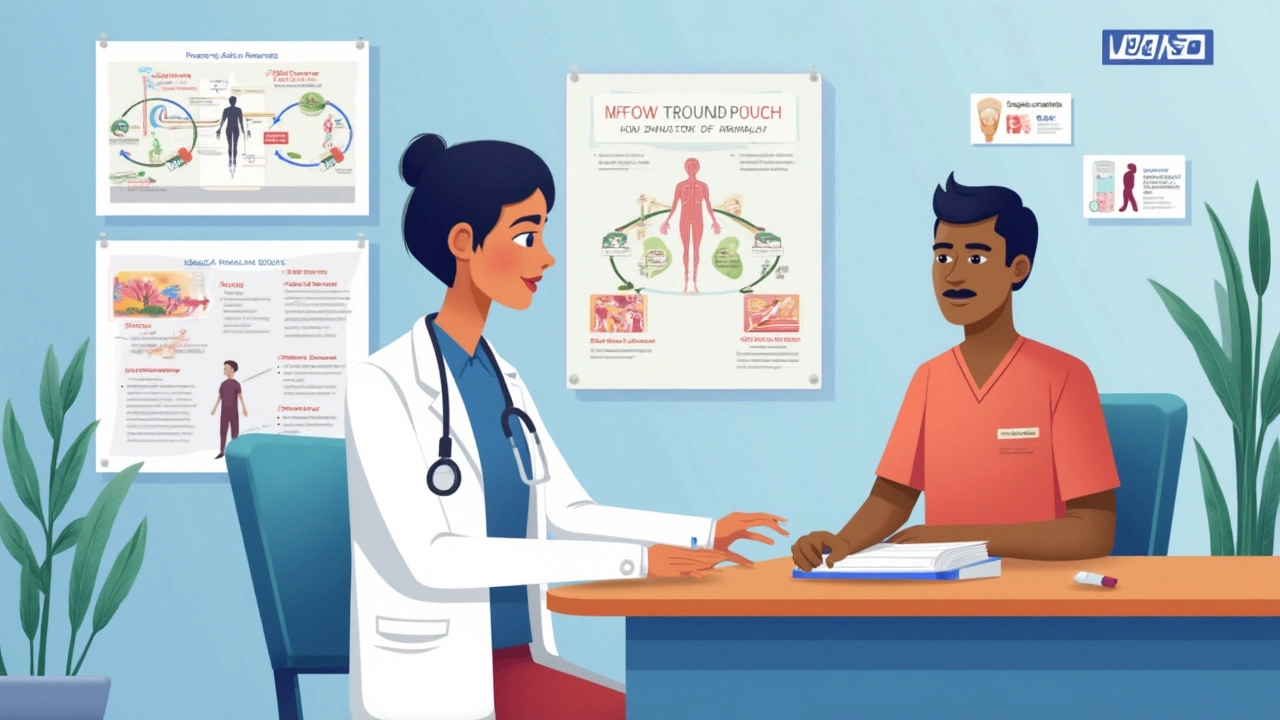Malaria may not top the news, but it still claims hundreds of thousands of lives every year, especially in tropical regions from sub-Saharan Africa to Southeast Asia. One of the key tools in the fight is Primaquine—famous among doctors, but almost never mentioned in travel magazines or guidebooks, unless you’re knee-deep in the fine print. But here’s the twist: Primaquine is both incredibly powerful and potentially risky if you don’t use it right. Miss a crucial detail, and you could end up worse off than when you started. The stakes are high, whether you’re gearing up for a trek through the Amazon or simply living where mosquitoes outnumber humans. Surviving—and thriving—starts with knowing how to safely use Primaquine.
How Primaquine Works and When It's Needed
Let’s break down what makes Primaquine special. Most malaria drugs only fight the bugs in your bloodstream. Primaquine, however, targets the “hidden” forms of malaria prevention, especially those caused by Plasmodium vivax and Plasmodium ovale. These forms can lay dormant in the liver for weeks or even months, only to flare up long after you think you’re in the clear. Primaquine steps in to clear those ghosts from the liver, making it the only widely available medicine that can pull off what’s called a “radical cure.” Without it, you risk relapsing malaria, which can hit again and again.
The decision about whether you need Primaquine isn’t straightforward. If you travel to or live in places where P. vivax or P. ovale are common—think Papua New Guinea, India, or Venezuela—it’s often recommended as part of the treatment or to stop relapses. But for malaria types caused mainly by Plasmodium falciparum (the deadliest one), Primaquine usually isn’t your main line of defense. Sometimes, it’s given as a single dose to clear out parasites that can infect mosquitoes after treatment, cutting down the spread of malaria in whole communities.
A key thing many miss: Primaquine is not your everyday malaria pill like Malarone or doxycycline, which you pop for daily prevention. Instead, it's used in three main ways:
- Radical cure of P. vivax or P. ovale malaria (to wipe out liver forms and prevent relapse)
- As a gametocytocide to clear infectious stages after P. falciparum treatment (usually a single dose)
- Rarely, as a primary preventive (prophylaxis) in special cases
Doctors don’t hand it out to everyone, and there are restrictions based on age, pregnancy, and certain blood conditions. If your doctor brings up a “G6PD test,” pay attention—that decision could save your life. We’ll get to that soon.

Mastering the Safe Use of Primaquine: Steps, Risks, and Key Dosage Rules
Primaquine’s effectiveness is no secret, but it comes with a big asterisk: safety. For a drug that’s been around since the 1950s, its side effects—and the tests you have to do before starting—are a game-changer compared to typical malaria meds.
First, you can’t just take Primaquine off the shelf. You need a prescription, and most doctors will insist on a G6PD test before writing one. What’s G6PD? It stands for glucose-6-phosphate dehydrogenase, an enzyme your red blood cells need to function properly. Some people (up to 400 million worldwide!) have a deficiency in this enzyme. Here’s why you should care: with G6PD deficiency, taking Primaquine can cause your red blood cells to burst—sometimes severely enough to land you in the hospital. That risk is so real, the World Health Organization makes the G6PD test mandatory before prescribing Primaquine almost everywhere.
This table shows why testing counts:
| Population Group | Estimated % with G6PD Deficiency |
|---|---|
| Sub-Saharan Africa | 5-25% |
| South & Southeast Asia | 5-15% |
| Europe & North America | 0.1-1% |
| Middle East | 3-10% |
If you’re in a higher-risk region or have ancestry from those areas, don’t skip the test. For kids, the elderly, and people with chronic illnesses, the stakes are even higher.
So how do you use Primaquine safely?
- Get the G6PD test first. This is not optional!
- Follow your doctor’s instructions to the letter. Dosage varies by age, body weight, and reason for use (treatment, relapse prevention, or other).
- Standard dose for adults, when used for radical cure, is usually 15 mg (base) once daily for 14 days, but some regions use higher doses or shorter courses; your doctor knows best for your area and risk.
- Take with food to reduce tummy upset. Primaquine can cause mild to severe abdominal cramps or nausea if taken on an empty stomach.
- If you forget a dose, don’t double up—just take the next one as prescribed and let your provider know.
- Watch for side effects—most people may feel some mild nausea or stomach pain (10-20%), but if you notice yellow skin, dark urine, severe fatigue, or pale skin (signs of anemia), get medical help immediately.
- Don’t take Primaquine if you’re pregnant or breastfeeding unless your doctor has done a full assessment—risk to the baby is not fully understood.
- For kids, dosing is carefully calculated by weight—don’t try to ‘guesstimate’ or split adult tablets.
- Extra care if you have heart conditions or are taking other medicines that can cause anemia or prolong the QT interval (your doctor will know what to check).
- After finishing the course, let your provider know if you have any fever or symptoms for several months. Recurrence does happen, and sometimes it means another round, or a different plan altogether.
Making things trickier, Primaquine is not available everywhere, and some countries have limited supplies. If your travel clinic or pharmacy can’t get it, talk to your doctor about alternatives—like tafenoquine (the newer cousin with longer action) or a different drug plan that fits your route and history.

Smart Tips and Real-Life Scenarios: Handling Side Effects, Missed Doses, and Travel Surprises
If you’re anything like me, medications make you a little anxious—especially when the label says things like “can cause severe anemia” or “only use with proper testing.” Living in Southeast Asia for a few years opened my eyes to how locals approach Primaquine: with a mix of caution, respect, and a little skepticism about Western medicine’s one-size-fits-all approach. The truth is, everyone’s body reacts a bit differently. Some breeze through the course with little more than mild stomach grumbling. Others may have to stop partway due to side effects.
First up: What should you actually expect if you start taking Primaquine? Mild side effects are surprisingly common—think nausea, cramping, or a metallic taste. Rare but dangerous effects (mostly related to G6PD deficiency) include severe fatigue, jaundice, shortness of breath, or rapid heart rate. Anytime you spot dark tea-colored urine or feel faint, call a doctor quickly.
A few personal hacks I’ve learned from doctors and locals alike:
- Eat a light meal before each dose—never take it on a truly empty stomach.
- Have a stash of bland, familiar foods handy (crackers, bananas, rice) just in case nausea hits hard.
- If you need to take Primaquine outside of your home country, check for local brands or names. In some countries, the same medicine comes under different brand names or tablet strengths.
- Keep a small note in your wallet listing any allergies, chronic conditions, and your recent medicines—including Primaquine and your G6PD status—just in case you have to visit a local clinic.
- If you’re traveling in remote areas, ask your clinic for advice on what to do if you vomit within one hour of taking a dose (sometimes you may need to repeat the dose, but only if advised by your provider).
Missing a dose may happen, especially on long trips or busy expeditions. Don’t panic. Take the next scheduled dose as usual and keep moving. The key is not to skip multiple days. If you miss more than one, your doctor may have you start the course again or extend your treatment.
Many people worry about drug interactions. Here’s the basic deal: Primaquine can react with meds like rifampin, other antimalarials, or drugs that cause hemolysis (breakdown of red blood cells), but most healthy people with no chronic meds will have zero issues. Still, mention every supplement and med you use—prescribed or herbal—when planning your malaria strategy.
Here’s a quick reference table with possible side effects and how common they are in treated patients according to large-scale reviews:
| Side Effect | Commonality (%) |
|---|---|
| Nausea | 13-20% |
| Abdominal pain | 5-10% |
| Headache | 5-8% |
| Rare/Severe Anemia* | <0.1% |
| Methemoglobinemia (blue tint to skin, lips) | <2% |
*Almost always related to G6PD deficiency and not a problem for most people tested and cleared to use Primaquine.
For long-term residents in malaria-endemic areas, doctors may suggest annual or periodic Primaquine to prevent relapsing infections. These “mass drug administrations” require careful follow-up and community education, especially since rumors or past bad experiences can make folks wary of starting or finishing the course. The more candid you are about your medication history, the better equipped your provider is to tailor the safest plan for you.
One thing’s for sure: Right now, there’s no perfect ‘set it and forget it’ malaria pill for everyone. But with careful steps—testing, smart scheduling, watching for side effects, and staying in touch with trusted doctors—you can take Primaquine confidently and safely whether you’re blazing a new trail or just trying to keep healthy at home.



19 Comments
Bailey Granstrom May 17, 2025 AT 21:26
Primaquine’s G6PD requirement isn’t optional-skip it and you gamble with hemolysis. The drug’s power is matched only by the need for strict medical oversight.
Melissa Corley May 21, 2025 AT 19:53
USA folks think they know everything about malaria meds, but most don’t even read the fine print 😜. G6PD testing is a must, not a suggestion, or you’ll end up with a busted red‑cell party.
Kayla Rayburn May 25, 2025 AT 21:06
Hey team, remember to get that G6PD screen before starting Primaquine – it’s the single most important step. If you’re cleared, follow the dosing schedule to the letter, and keep a log of each dose.
Dina Mohamed May 29, 2025 AT 22:20
Great overview!
Just a reminder: always take Primaquine with food, stay hydrated, and watch for any dark urine – that’s a red flag!
If you feel any unusual fatigue, get checked ASAP.
Kitty Lorentz June 2, 2025 AT 23:33
i feel you on the anxiety around meds it helps to have a small snack before each pill and keep a simple diary of how you feel day by day
inas raman June 7, 2025 AT 00:46
Friends, make sure your travel kit includes a copy of your G6PD test results – local clinics may not have the equipment. Also, carry a short note with your weight and dosage schedule; it saves precious time.
Jenny Newell June 11, 2025 AT 02:00
From a pharmacology standpoint, Primaquine’s half‑life and hepatic targeting demand adherence; missed doses can compromise the radical cure, leading to relapse of vivax.
Kevin Zac June 15, 2025 AT 03:13
In clinical practice we see that patients who synchronize their Primaquine intake with meals report fewer GI side effects. Also, using a pill organizer can prevent accidental double‑dosing.
Stephanie Pineda June 19, 2025 AT 04:26
When you bite into the reality of primaquine, you discover a tapestry woven from science, caution, and human resilience. First, the drug’s dual action-eradicating liver hypnozoites while also acting as a gametocytocide-makes it uniquely valuable in the malaria arsenal. Yet, this power is shackled by a genetic Achilles’ heel: G6PD deficiency, a condition that silently haunts up to 400 million souls worldwide. The biochemical cascade that follows an untested dose resembles a tiny war inside your erythrocytes, leading to hemolysis that can cascade into severe anemia. In practice, a simple point‑of‑care test can prevent this tragedy, turning a potential catastrophe into a routine precaution. Moreover, the dosing regimen-typically 15 mg daily for two weeks-requires disciplined adherence; any deviation dilutes its radical cure effect and opens the door to relapses that plague vivax‑endemic regions. Travelers often underestimate the importance of food intake with each tablet, but the gastric mucosa is more forgiving when a modest snack cushions the drug, reducing nausea and cramping. For those with comorbidities-cardiac arrhythmias, concurrent QT‑prolonging agents-the prescriber must weigh risks, sometimes opting for the newer tafenoquine despite its own complexities. Physicians also need to consider pregnancy; while primaquine is generally contraindicated, individual risk assessments may justify its use under strict monitoring. Observation after the course is crucial: a lingering fever or malaise months later could signal a breakthrough infection, demanding prompt re‑evaluation. In endemic communities, mass drug administration campaigns hinge on community trust; transparency about side effects and benefits fosters compliance. Finally, the psychological dimension-fear of side effects-can be mitigated by clear patient education, empowering individuals to recognize warning signs like dark urine, jaundice, or sudden fatigue. By marrying rigorous testing, precise dosing, and compassionate communication, primaquine transforms from a double‑edged sword into a life‑saving instrument in the global fight against malaria.
Anne Snyder June 23, 2025 AT 05:40
I find the side‑effect table especially useful; nausea affects about 15 % of patients, but severe anemia is <1 % when G6PD testing is done.
Rebecca M June 27, 2025 AT 06:53
Excellent article; however, note that “G6PD” should be capitalized consistently, and “primaquine” is a proper noun that merits initial capitalization when referring to the specific drug. Also, the phrase “the stakes are high” is vague-specify the clinical risks for clarity.
Bianca Fernández Rodríguez July 1, 2025 AT 08:06
i cant beleive people still skip the G6PD test its like playing russian roulette with your blood cells 😂.
Patrick Culliton July 1, 2025 AT 22:00
Skip the test and you’ll regret it.
Andrea Smith July 3, 2025 AT 01:46
While the article is comprehensive, I would advise readers to consult their local health authority for region‑specific dosing guidelines, as variations exist between endemic zones.
Gary O'Connor July 4, 2025 AT 05:33
yea, timetables can be a real pain, but having a note in ur pocket helps big time.
Justin Stanus July 8, 2025 AT 20:40
When I first started primaquine, the fear of hemolysis lingered like a shadow; the test gave me peace, yet the emotional weight of side‑effects still weighed heavily.
Claire Mahony July 14, 2025 AT 15:33
Honestly, many travelers underestimate how vital the G6PD check is, and that can turn a simple prophylaxis into a medical emergency.
Andrea Jacobsen July 20, 2025 AT 10:26
Absolutely, the key is to treat the test as non‑negotiable-once cleared, follow the prescribed schedule and monitor for any unusual symptoms.
Andrew Irwin July 26, 2025 AT 05:20
Just a gentle reminder: keep all medication records handy when traveling, especially in remote areas where medical resources are limited.